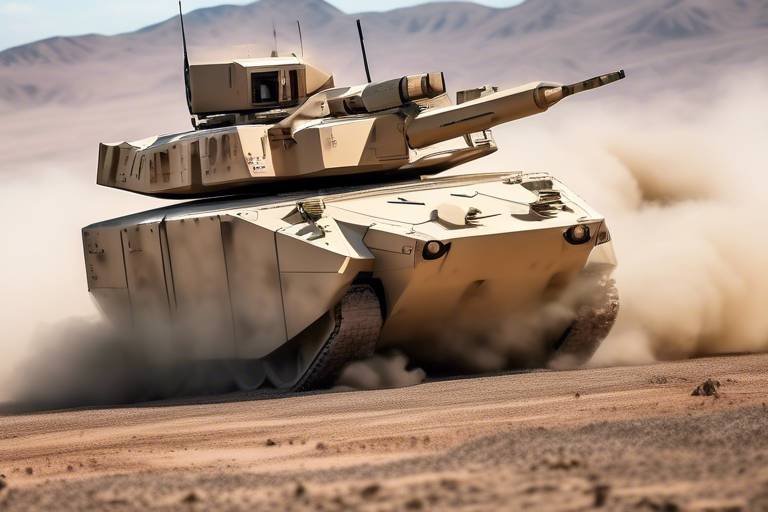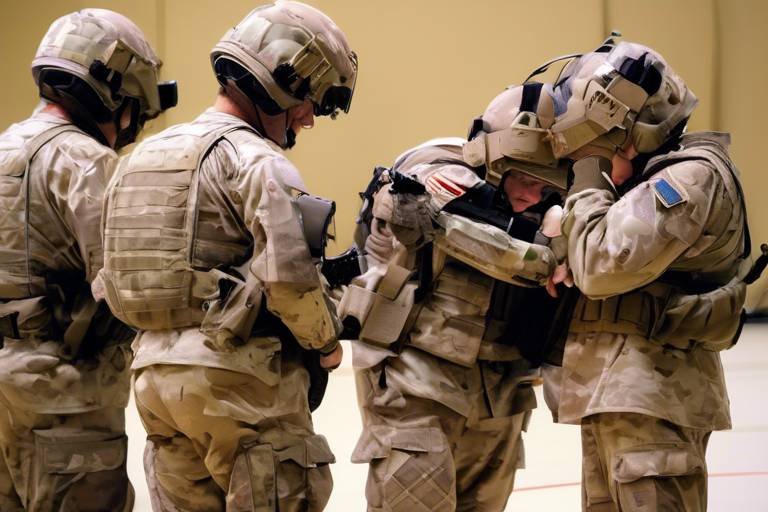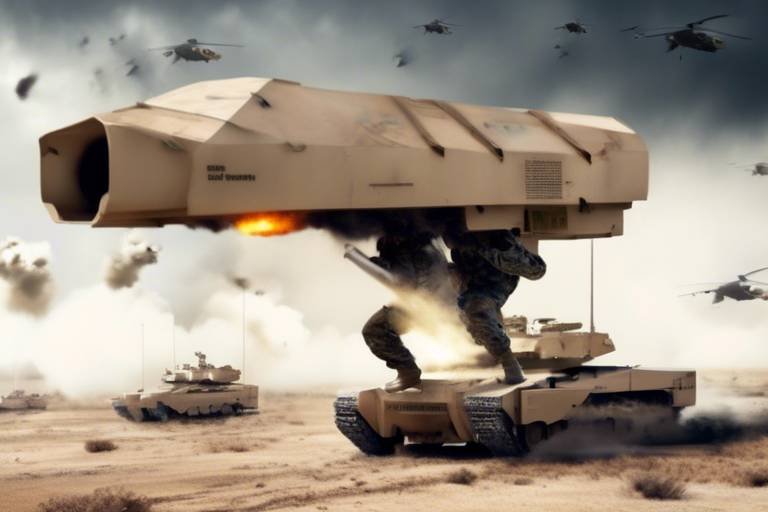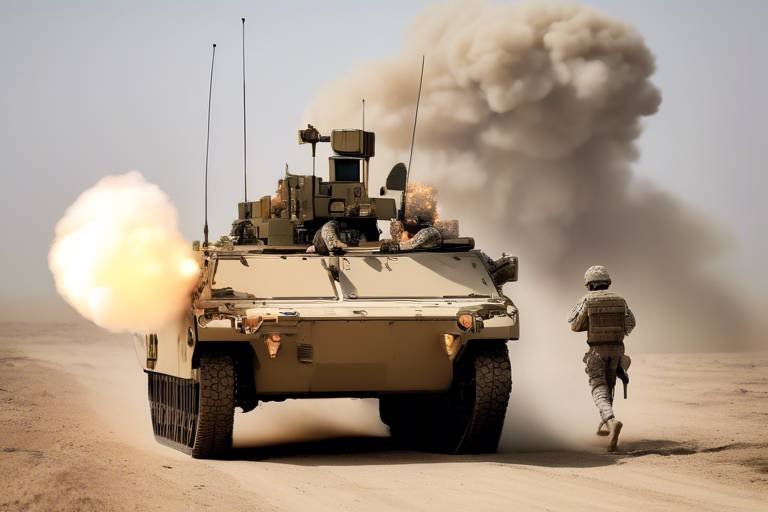Evaluating the Future of Ground-Based Defense Systems
As we navigate through the complexities of modern warfare, the significance of ground-based defense systems becomes increasingly evident. These systems are not just a relic of the past but are evolving to meet the demands of contemporary threats. In this article, we will explore the advancements, challenges, and implications of these systems, focusing on their pivotal role in national security and the technological innovations that drive them.
Ground-based defense systems encompass a variety of technologies, including missile defense systems, artillery, and surveillance platforms. The integration of advanced technologies such as artificial intelligence, machine learning, and unmanned systems is transforming how these assets operate. For instance, imagine a scenario where ground-based missile defense systems are equipped with AI that can predict and respond to incoming threats in real-time. This capability not only enhances their effectiveness but also ensures a quicker response time, potentially saving countless lives.
Moreover, the adaptability of these systems allows military forces to respond dynamically to various combat scenarios. The development of modular systems, which can be easily upgraded or modified, is a game-changer. This flexibility ensures that ground-based defenses can evolve alongside emerging threats, maintaining their relevance in an ever-changing battlefield landscape.
In understanding the future of ground-based defense systems, it's essential to recognize their strategic importance. These systems serve as the backbone of national security, providing essential support to air and naval forces. They create a multi-layered defense strategy that is crucial for protecting a nation's sovereignty. Without robust ground-based systems, the effectiveness of air and naval operations is significantly diminished, leading to vulnerabilities that adversaries could exploit.
As we delve deeper into this topic, we'll also examine how these ground-based systems integrate with air and naval forces. The synergy between these branches of the military is vital for effective defense. For example, ground-based radar systems can provide critical information to air forces, enhancing situational awareness and enabling coordinated responses to threats. This collaboration exemplifies how various military assets can work together to create a formidable defense posture.
Recent technological advancements have transformed ground-based defense systems, enhancing their effectiveness and adaptability. This section delves into emerging technologies and their integration into defense strategies.
Ground-based defense systems play a crucial role in national security. This section examines their strategic significance and how they complement other military assets in a comprehensive defense strategy.
The synergy between ground-based systems and air or naval forces is vital for effective defense. This subheading discusses how these branches work together to enhance overall military capabilities.
Effective joint operations require seamless coordination among various military branches. This section highlights the importance of communication and collaboration in maximizing the potential of ground-based defense systems.
Despite the benefits, integrating ground-based systems with other military branches poses challenges. This subsection explores the obstacles faced and potential solutions for improved interoperability.
Assessing the financial implications of ground-based defense systems is essential for informed decision-making. This section evaluates the costs versus the benefits of investing in these technologies.
The evolving nature of threats necessitates adaptive defense strategies. This section discusses potential future threats and how ground-based systems must evolve to counter them effectively.
As technology advances, cybersecurity becomes increasingly critical for ground-based defense systems. This subsection examines the vulnerabilities and strategies for safeguarding these systems against cyber threats.
Understanding global trends in defense spending is essential for evaluating the future of ground-based systems. This section provides insights into how nations prioritize their defense budgets in response to emerging threats.
- What are ground-based defense systems? Ground-based defense systems include various technologies designed to protect a nation from aerial threats, such as missiles and drones.
- How do ground-based systems integrate with other military branches? They work in conjunction with air and naval forces, enhancing overall military capabilities through shared intelligence and coordinated operations.
- What are the main challenges in integrating these systems? Challenges include technological compatibility, communication barriers, and the need for joint training exercises.
- How important is cybersecurity for ground-based defense systems? Extremely important, as vulnerabilities can be exploited by adversaries to compromise national security.

Technological Innovations in Ground-Based Defense
Recent technological advancements have revolutionized ground-based defense systems, making them more effective and adaptable than ever before. Imagine a world where military operations are not just about brute force but about smart technology that can predict threats and respond accordingly. This new era of defense is characterized by the integration of cutting-edge technologies such as artificial intelligence (AI), unmanned systems, and advanced sensors. These innovations are not just enhancements; they are game-changers that redefine how ground forces operate on the battlefield.
One of the most significant advancements is the use of AI and machine learning algorithms in decision-making processes. By analyzing vast amounts of data in real-time, these systems can identify potential threats faster than any human operator. This capability allows ground-based defense units to deploy resources more efficiently and respond to emerging situations with unprecedented speed. For instance, AI can help in predicting enemy movements or assessing the battlefield environment, thus giving commanders a critical edge.
Moreover, the integration of unmanned ground vehicles (UGVs) has transformed how military forces approach reconnaissance and combat. These robotic systems can operate in hazardous environments without risking human lives, providing valuable intelligence and even engaging in combat scenarios. The use of UGVs not only enhances operational safety but also allows for a more versatile approach to ground defense. Imagine sending a fleet of robots to gather intel while your troops remain safely behind cover—this is the future of warfare.
Additionally, the deployment of advanced sensor technologies has significantly improved situational awareness on the ground. Modern sensors can detect and analyze a wide range of threats, from incoming missiles to enemy troop movements. These sensors are often integrated with data networks, ensuring that information flows seamlessly across all units involved in an operation. As a result, ground forces can maintain a comprehensive understanding of the battlefield, allowing for quicker and more informed decision-making.
However, with these advancements come new challenges. The increased reliance on technology means that military personnel must be adequately trained to use these sophisticated systems effectively. Moreover, the potential for cybersecurity threats looms large, as adversaries may attempt to disrupt or manipulate these technologies. As ground-based defense systems become more interconnected, ensuring their security becomes paramount. It’s a double-edged sword—while technology enhances capabilities, it also introduces vulnerabilities that must be addressed.
In summary, the landscape of ground-based defense is undergoing a remarkable transformation driven by technological innovations. The integration of AI, unmanned systems, and advanced sensors is not just enhancing military operations; it is reshaping the very fabric of how defense is conducted. As these technologies continue to evolve, they promise to play an even more critical role in national security and defense strategies. The future of ground-based defense looks brighter, but it requires ongoing adaptation and vigilance to navigate the complexities of modern warfare.

Strategic Importance of Ground-Based Systems
In the ever-evolving landscape of modern warfare, the strategic importance of ground-based defense systems cannot be overstated. These systems serve as the backbone of a nation’s military capabilities, providing a robust framework for national security. Ground-based systems are not just standalone entities; they are integral components that interact with air and naval forces to form a cohesive defense strategy. Imagine a well-orchestrated symphony, where each instrument plays its part in harmony. That is precisely how ground-based systems function within the larger military ecosystem.
One of the key roles of ground-based systems is their ability to provide immediate response to threats. Unlike their airborne or naval counterparts, which might take time to mobilize, ground forces can often react swiftly to emerging dangers. This immediacy is crucial, especially in situations where time is of the essence. For instance, during a missile attack, ground-based air defense systems can engage targets almost instantaneously, providing a critical layer of protection to both military and civilian assets.
Moreover, ground-based systems offer unparalleled situational awareness. Equipped with advanced radar and surveillance technologies, these systems can detect and track threats over vast distances. This capability allows military planners to make informed decisions quickly. It’s like having a watchful eye that never blinks, constantly scanning the horizon for potential dangers. The integration of artificial intelligence and machine learning into these systems further enhances their ability to analyze data and predict threats, making them invaluable in today’s complex battlefield.
Additionally, ground-based systems contribute significantly to force multiplication. By providing support to air and naval operations, they enhance the overall effectiveness of military campaigns. For example, ground-based missile systems can target enemy ships or aircraft, creating a multi-layered defense that complicates adversaries' attack strategies. This synergy among different military branches is essential for maintaining a strategic advantage, as it ensures that all available resources are utilized effectively.
However, the strategic importance of ground-based systems extends beyond immediate military applications. They also play a vital role in diplomatic relations and deterrence strategies. The mere presence of advanced ground-based defense systems can act as a deterrent to potential aggressors, signaling a nation's readiness to defend its sovereignty. This aspect of ground-based systems is particularly crucial in regions with geopolitical tensions, where the balance of power can shift rapidly. A robust ground defense can reassure allies and deter adversaries, contributing to a more stable international environment.
In conclusion, the strategic importance of ground-based defense systems is multifaceted, encompassing immediate threat response, situational awareness, force multiplication, and diplomatic influence. As nations continue to invest in these systems, their role in shaping the future of military operations and national security will only grow. Understanding this importance is essential for policymakers and military strategists alike, as they navigate the complexities of modern defense challenges.
- What are ground-based defense systems?
Ground-based defense systems are military assets designed to detect, intercept, and neutralize threats from the ground, including missiles, drones, and enemy aircraft. - How do ground-based systems enhance national security?
They provide immediate response capabilities, situational awareness, and force multiplication, which are vital for effective defense strategies. - Why are ground-based systems important in joint military operations?
They work in synergy with air and naval forces, creating a comprehensive defense that maximizes military effectiveness. - What role do ground-based systems play in deterrence?
Their presence can deter potential aggressors by signaling a nation’s readiness to defend itself, thus contributing to geopolitical stability.

Integration with Air and Naval Forces
When we think of military might, the image of ground troops on the battlefield often comes to mind. However, the reality of modern warfare is far more complex. The integration of ground-based defense systems with air and naval forces represents a paradigm shift in how nations approach their military strategies. This synergy is not just about having different branches of the military; it’s about creating a cohesive force that can respond to threats more effectively than ever before.
Imagine a well-orchestrated symphony where each musician plays a vital role, contributing to a harmonious performance. In the military context, this symphony is the collaboration between ground, air, and naval forces. Each branch brings its unique strengths to the table, and when they work together, they create a formidable defense mechanism. For instance, ground-based missile systems can provide crucial data and targeting information to air forces, while naval assets can offer logistical and operational support from the sea. This interdependence enhances overall military capabilities, allowing for rapid response and adaptability in the face of evolving threats.
Moreover, the integration of these systems is facilitated by advanced technologies such as real-time data sharing and communication networks. These technologies ensure that all branches of the military can operate with a shared understanding of the battlefield. For example, ground units equipped with sophisticated radar can detect incoming threats and relay that information to air defense systems to intercept potential attacks. This kind of collaboration not only improves efficiency but also saves lives by allowing for quicker decision-making in high-stakes situations.
However, achieving seamless integration is not without its challenges. Different branches often operate on varying technological platforms, which can lead to compatibility issues. To address these challenges, military organizations are investing in joint training exercises and developing standardized protocols to ensure that all forces can communicate effectively. By fostering a culture of collaboration, armed forces can enhance their operational readiness and ensure that they are prepared to face any threat that arises.
In conclusion, the integration of ground-based defense systems with air and naval forces is not just a strategic necessity; it's an operational imperative. As threats become more sophisticated, the ability to coordinate across different military branches will define the success of national defense strategies. The future of warfare will rely heavily on this integrated approach, making it essential for military planners to prioritize collaboration and interoperability.
- Why is integration between military branches important?
Integration ensures that different branches can work together efficiently, enhancing overall military effectiveness and response times.
- What technologies facilitate this integration?
Technologies such as real-time data sharing, advanced communication networks, and joint training exercises are key to successful integration.
- What challenges do military branches face in integration?
Challenges include compatibility issues between different technological platforms and the need for standardized protocols for communication.

Joint Operations and Coordination
In the fast-paced world of modern warfare, joint operations and seamless coordination among various military branches are not just beneficial; they are essential. Imagine a well-oiled machine where every part works in perfect harmony to achieve a common goal. That’s the essence of joint operations. Ground-based defense systems, such as missile defense installations and artillery units, must operate in concert with air and naval forces to create a robust defense network capable of responding to a multitude of threats.
Effective coordination involves not only physical proximity but also real-time communication. This is where advanced technology plays a pivotal role. For instance, integrating data from ground sensors with aerial reconnaissance can provide a comprehensive picture of the battlefield. This synergy ensures that every military asset is utilized to its fullest potential, allowing for rapid decision-making and deployment of resources. The ability to share information across platforms can drastically reduce response times during critical moments.
Moreover, joint operations are not merely about combining forces; they require a cultural shift within military organizations. Each branch has its own protocols, terminologies, and operational styles. Bridging these differences is crucial for success. Training exercises that simulate joint operations can foster understanding and cooperation among units, breaking down barriers and building trust. When soldiers from different branches train together, they learn to appreciate each other's strengths and capabilities, leading to a more cohesive fighting force.
However, challenges do exist. Differences in command structures and operational priorities can create friction. For example, ground forces may prioritize securing a territory, while air forces might focus on aerial superiority. To mitigate these conflicts, it is vital to establish clear command and control protocols that outline the roles and responsibilities of each branch during joint operations. This clarity helps in aligning objectives and ensures that all units are working towards the same mission, ultimately enhancing operational efficiency.
In conclusion, the success of joint operations and coordination hinges on communication, training, and mutual respect among military branches. By fostering an environment where collaboration is prioritized, ground-based defense systems can integrate seamlessly with air and naval forces, creating a formidable defense posture that is agile and responsive to the ever-evolving landscape of modern threats.
- What are joint operations? Joint operations refer to military actions conducted by multiple branches of the armed forces working together towards a common objective.
- Why is coordination important in military operations? Coordination ensures that all military assets are utilized effectively, reducing response times and enhancing overall mission success.
- What challenges do military branches face in joint operations? Challenges include differences in command structures, operational priorities, and communication barriers that can hinder effective collaboration.
- How can training improve joint operations? Joint training exercises help military personnel understand each other's capabilities and foster a culture of cooperation and trust.
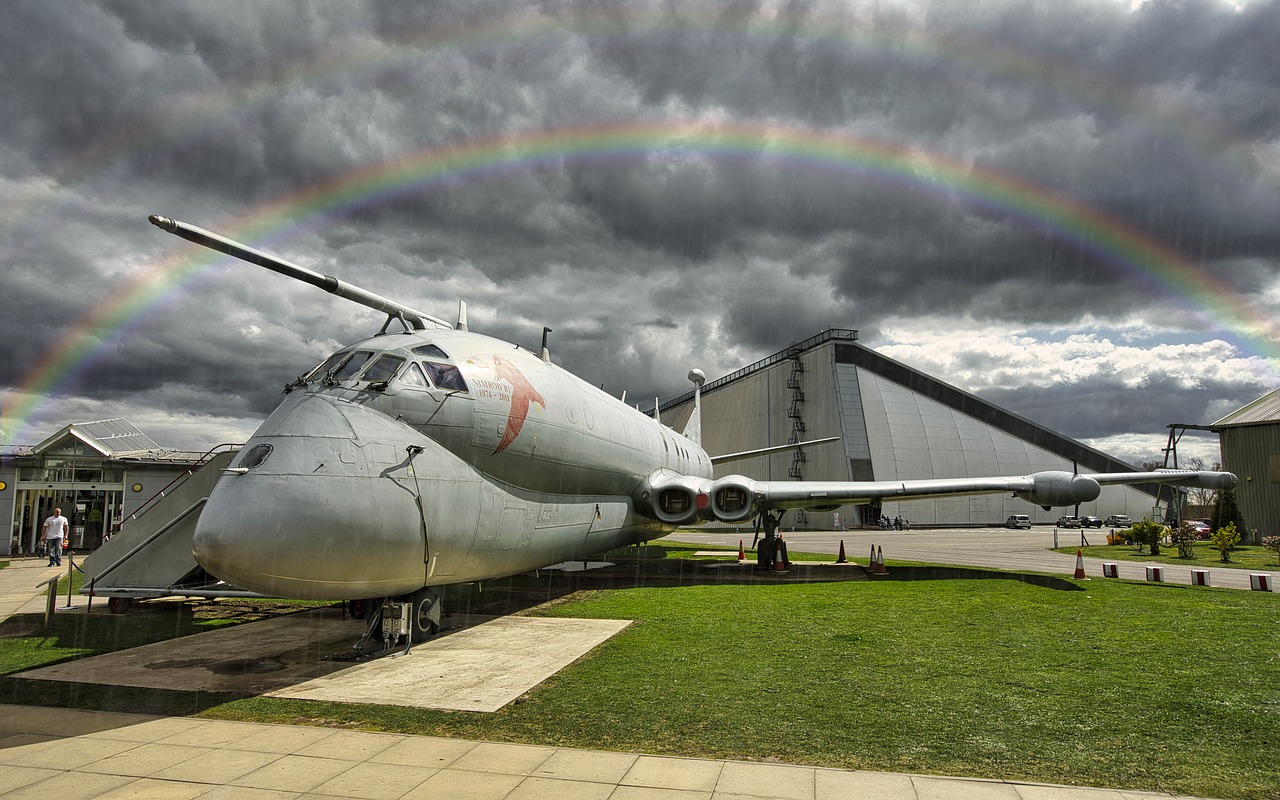
Challenges in Integration
Integrating ground-based defense systems with other military branches is like trying to fit together pieces of a complex puzzle. Each piece is vital, yet they often come with their own unique shapes and challenges. One of the primary obstacles is the communication gap among different branches of the military. Imagine coordinating a symphony where each musician plays a different tune; without a conductor, the result is chaotic. Similarly, without effective communication channels, ground forces, air units, and naval fleets can struggle to operate in harmony.
Another significant challenge lies in the technological disparity between different systems. As technology evolves rapidly, various military branches may adopt different platforms and technologies at varying paces. This can lead to compatibility issues. For instance, a ground-based missile defense system might not seamlessly integrate with an air force's command and control systems, resulting in delays or miscommunication during critical operations. Such discrepancies can hinder the effectiveness of joint operations, especially in high-pressure situations where every second counts.
Furthermore, the training and operational doctrine of different military branches can complicate integration efforts. Each branch has its own protocols and procedures, which can lead to misunderstandings and inefficiencies. For example, ground troops trained under specific doctrines may not be familiar with the operational tactics of naval forces, and vice versa. This lack of mutual understanding can create friction during joint missions, potentially compromising mission success.
To address these challenges, military leaders must prioritize interoperability during the planning and development stages of defense systems. This involves not only investing in compatible technologies but also fostering a culture of collaboration through joint training exercises and shared operational frameworks. Here are some strategies that can help improve integration:
- Standardization of Communication Protocols: Establishing common communication standards can significantly enhance information sharing across branches.
- Joint Training Programs: Conducting regular joint exercises can help personnel from different branches understand each other's capabilities and operational methods.
- Investment in Interoperable Technologies: Prioritizing the development of systems that can easily integrate with existing platforms across branches.
Ultimately, overcoming these integration challenges is essential for creating a cohesive defense strategy that maximizes the strengths of ground-based systems while ensuring that they work effectively alongside air and naval forces. By addressing these issues head-on, military leaders can pave the way for a more unified and effective defense posture, capable of responding to modern threats with agility and precision.
Q1: What are the main challenges in integrating ground-based defense systems?
A1: The main challenges include communication gaps between military branches, technological disparities, and differences in training and operational doctrines.
Q2: Why is interoperability important for military operations?
A2: Interoperability ensures that different military branches can work together seamlessly, enhancing overall mission effectiveness and response times during operations.
Q3: How can joint training programs improve integration?
A3: Joint training programs foster understanding and collaboration among various branches, allowing personnel to learn each other's capabilities and operational methods.

Cost-Benefit Analysis of Ground-Based Systems
When it comes to evaluating ground-based defense systems, a cost-benefit analysis is essential. This analysis not only sheds light on the financial implications but also helps in understanding the overall value these systems bring to national security. Imagine investing in a high-tech security system for your home; you’d want to know if the cost is justified by the peace of mind it provides. Similarly, for governments, the stakes are much higher, and the implications of their decisions can affect millions.
First, let’s break down the costs associated with ground-based defense systems. These can include initial acquisition costs, maintenance expenses, personnel training, and operational costs. For instance, consider the following table that outlines some key financial aspects:
| Cost Component | Estimated Cost |
|---|---|
| Initial Acquisition | $500 million |
| Maintenance (Annual) | $50 million |
| Personnel Training (Annual) | $10 million |
| Operational Costs (Annual) | $30 million |
On the flip side, the benefits of investing in these systems can be substantial. They provide enhanced security, deter potential threats, and can even be a source of technological innovation that spills over into civilian applications. For example, advanced radar systems developed for military use can lead to improvements in weather forecasting technologies. Thus, the benefits can be categorized into tangible and intangible forms:
- Tangible Benefits: Direct contributions to national security, protection of critical infrastructure, and potential economic savings from avoided conflict.
- Intangible Benefits: Increased national morale, international prestige, and the fostering of technological advancements.
However, it's crucial to approach this analysis with a critical eye. The financial outlay for ground-based defense systems can be staggering, and with pressing needs in other sectors like healthcare and education, decision-makers must weigh these priorities carefully. Are we investing wisely? Is the return on investment (ROI) justifiable in the long term? These are questions that require thorough investigation and debate.
Moreover, as we look to the future, the landscape of threats is changing. The emergence of asymmetric warfare, cyber threats, and even climate-related challenges means that ground-based systems need to be adaptable and resilient. Thus, the cost-benefit analysis must also factor in the potential for these systems to evolve in response to new challenges. It’s akin to upgrading your smartphone; the latest model may be pricier, but the enhanced features and security could save you from future headaches.
In conclusion, a comprehensive cost-benefit analysis of ground-based defense systems is not just about crunching numbers. It's about understanding their role in a broader context of national security, technological advancement, and global stability. As nations grapple with budget constraints and evolving threats, the decisions made today will shape the defense landscape for generations to come.
- What are ground-based defense systems? Ground-based defense systems are military installations and technologies designed to protect a nation from various threats, including missile attacks and ground invasions.
- How do these systems integrate with other military branches? They work in synergy with air and naval forces to create a comprehensive defense strategy, enhancing overall military capabilities.
- What are the main challenges in implementing these systems? Key challenges include high costs, the need for advanced technology, and the integration with other military branches.
- Why is cost-benefit analysis important? It helps decision-makers evaluate whether the financial investment in ground-based systems is justified by the security benefits they provide.

Future Threats and Defense Adaptations
The landscape of global security is continually shifting, and with it, the threats we face are evolving at an unprecedented pace. As we look toward the future, it’s essential to understand not only the nature of these threats but also how ground-based defense systems must adapt to effectively counter them. Today, we are not just dealing with traditional military confrontations; we are facing a myriad of challenges including asymmetric warfare, cyber threats, and even the potential for space-based conflicts. Each of these requires a unique response and a rethinking of our defense strategies.
One of the most pressing concerns is the rise of cybersecurity threats. As ground-based defense systems become more interconnected with advanced technologies, they also become more vulnerable to cyberattacks. Imagine a scenario where a nation’s defense systems are compromised not through physical means, but through a well-executed cyber intrusion. This shift necessitates that military strategists not only invest in cutting-edge technology but also prioritize cyber resilience. Ground-based systems will need to incorporate advanced cybersecurity measures to safeguard against potential breaches. This includes training personnel in cyber defense tactics and investing in technologies that can detect and respond to cyber threats in real-time.
Moreover, the proliferation of unmanned systems is changing the battlefield dynamics. Drones and autonomous vehicles are becoming more common, both in surveillance and combat roles. Ground-based defense systems must adapt to counter these unmanned threats effectively. This might involve developing new radar technologies or enhancing existing systems to detect and neutralize drone swarms. The integration of artificial intelligence into ground-based systems can also provide a significant edge, allowing for faster decision-making and improved situational awareness.
Another critical aspect to consider is the potential for space-based conflicts. As nations vie for dominance in space, ground-based defense systems will need to evolve to address threats that may originate beyond our atmosphere. This could involve the development of missile defense systems capable of intercepting threats launched from space or enhancing ground-based sensors to track objects in orbit. The future of warfare may very well extend beyond the ground, and our defense systems must be prepared to adapt accordingly.
To summarize, the future threats facing ground-based defense systems are multifaceted and complex. They require a proactive approach to adaptation and innovation. Here are some key areas where adaptations will be necessary:
- Cybersecurity Enhancements: Developing robust cybersecurity protocols to protect against cyber threats.
- Unmanned System Countermeasures: Investing in technologies to detect and neutralize drones and autonomous vehicles.
- Space Defense Strategies: Preparing ground-based systems to address potential threats from space.
In conclusion, as we navigate the uncertainties of the future, it’s clear that ground-based defense systems must not only be reactive but also proactive. The integration of advanced technologies, a focus on cybersecurity, and preparation for new types of warfare will determine the effectiveness of these systems in safeguarding national security. The road ahead is challenging, but with the right adaptations, we can ensure that our ground-based defenses remain formidable against any threat.
Q1: What are the main future threats to ground-based defense systems?
A1: The main future threats include cybersecurity risks, the rise of unmanned systems like drones, and potential conflicts extending into space.
Q2: How can ground-based defense systems adapt to these threats?
A2: Adaptations can include enhancing cybersecurity measures, developing countermeasures for unmanned systems, and preparing for space-based threats.
Q3: Why is cybersecurity becoming increasingly important for defense systems?
A3: As ground-based defense systems become more technologically advanced and interconnected, they become more vulnerable to cyberattacks, making robust cybersecurity essential.

Cybersecurity Concerns
As we dive deeper into the realm of ground-based defense systems, one cannot overlook the looming shadow of . In an age where technology reigns supreme, the integration of digital systems into military operations has become a double-edged sword. On one hand, these advancements enhance operational efficiency and effectiveness; on the other, they expose critical infrastructures to a plethora of vulnerabilities. Imagine a fortress with impenetrable walls but a gaping hole in its cyber defenses—this is the precarious position many military organizations find themselves in today.
The reality is that ground-based defense systems are increasingly reliant on networked technologies to operate effectively. This reliance opens the door to cyber attacks that can disrupt communication, compromise sensitive data, and even manipulate operational capabilities. For instance, consider a scenario where an enemy successfully infiltrates a ground-based missile defense system. They could potentially disable it or redirect its capabilities, turning a protective measure into a weapon against its own forces. The implications of such breaches are staggering and highlight the urgent need for robust cybersecurity measures.
To better understand the landscape of cybersecurity threats, we can categorize them into several types:
- Malware Attacks: Malicious software designed to infiltrate and damage systems.
- Phishing Schemes: Deceptive tactics used to trick personnel into revealing sensitive information.
- Denial of Service (DoS) Attacks: Attempts to make systems unavailable by overwhelming them with traffic.
- Insider Threats: Risks posed by individuals within the organization who may exploit their access for malicious purposes.
Addressing these cybersecurity challenges requires a multi-faceted approach. First and foremost, military organizations must invest in advanced cybersecurity technologies that can detect and respond to threats in real-time. This includes deploying artificial intelligence (AI) and machine learning algorithms that can analyze patterns and identify anomalies before they escalate into full-blown attacks.
Moreover, training personnel to recognize and respond to cyber threats is equally crucial. Regular drills and simulations can prepare teams to act swiftly and decisively in the event of a cyber incident. By fostering a culture of cybersecurity awareness, organizations can significantly reduce the risk of human error, which is often the weakest link in the security chain.
Lastly, collaboration with external cybersecurity experts and agencies can provide additional layers of protection. By sharing intelligence and best practices, military forces can stay ahead of emerging threats and fortify their defenses. In essence, the fight against cyber threats is not just a technical challenge; it’s a comprehensive strategy that encompasses people, processes, and technology.
In conclusion, as ground-based defense systems evolve and become more intertwined with digital technologies, addressing cybersecurity concerns will be paramount. The stakes are high, and the consequences of inaction could be catastrophic. By prioritizing cybersecurity, military organizations can ensure that their ground-based systems remain a formidable line of defense in an increasingly complex and hostile environment.
- What are the main cybersecurity threats to ground-based defense systems? The main threats include malware attacks, phishing schemes, denial of service attacks, and insider threats.
- How can military organizations improve their cybersecurity posture? By investing in advanced technologies, training personnel, and collaborating with external experts.
- Why is cybersecurity important for national security? Because breaches can compromise critical operations and expose sensitive information, jeopardizing national defense.
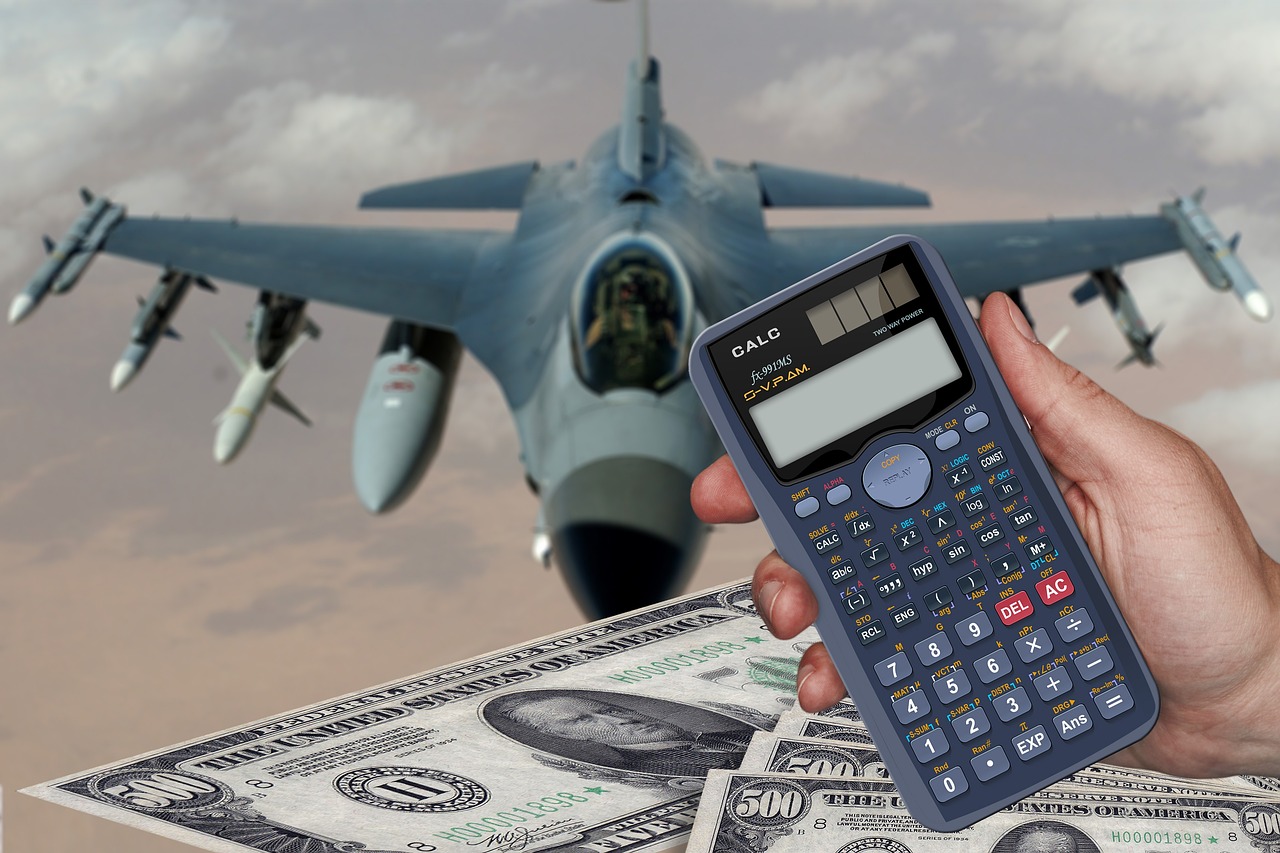
Global Trends in Defense Spending
The landscape of global defense spending is shifting dramatically, influenced by a myriad of factors including geopolitical tensions, technological advancements, and the ever-evolving nature of warfare. Nations across the globe are reevaluating their defense budgets, often increasing them in response to perceived threats. For instance, countries like China and Russia have significantly ramped up their military expenditures, reflecting their ambitions on the world stage and the desire to enhance their military capabilities.
According to recent reports, global defense spending reached an all-time high, surpassing $2 trillion in 2022. This surge can be attributed to several key trends:
- Increased Geopolitical Tensions: The ongoing conflicts and tensions in regions such as Eastern Europe and the South China Sea have prompted nations to bolster their military readiness.
- Technological Advancements: The race to develop cutting-edge technologies such as artificial intelligence, drones, and cyber warfare capabilities has led to increased investments in defense.
- Focus on Cybersecurity: As cyber threats become more sophisticated, nations are allocating more resources to protect their critical infrastructure and military networks.
Moreover, a significant portion of defense budgets is being directed towards ground-based defense systems, which are viewed as essential components of a comprehensive military strategy. Countries are investing not only in traditional hardware but also in innovative technologies that enhance the effectiveness of these systems. This includes the integration of artificial intelligence and machine learning to improve decision-making and operational efficiency.
To illustrate the shifts in defense spending, consider the following table that highlights the top five countries with the highest military expenditures in 2022:
| Country | Defense Spending (in billion USD) |
|---|---|
| United States | 877 |
| China | 293 |
| India | 76 |
| Russia | 65 |
| United Kingdom | 56 |
This table clearly demonstrates the disparity in defense spending among nations, with the United States leading by a substantial margin. Such investments not only reflect a country's military priorities but also its strategic vision for the future.
In conclusion, as we navigate through an increasingly complex global security environment, the trends in defense spending will continue to evolve. Countries will need to adapt their strategies and budgets to meet new challenges, ensuring that their ground-based defense systems remain effective and relevant. The interplay between technological innovation and geopolitical dynamics will be pivotal in shaping the future of national defense strategies worldwide.
Q1: Why are countries increasing their defense budgets?
A1: Countries are increasing their defense budgets primarily due to rising geopolitical tensions, the need for advanced technologies, and the growing threat of cyber attacks.
Q2: How does technological advancement affect defense spending?
A2: Technological advancements lead to increased investments in new military capabilities, requiring countries to allocate more funds to research and development.
Q3: What role do ground-based defense systems play in national security?
A3: Ground-based defense systems are crucial for protecting national interests, providing a first line of defense against various threats, and complementing other military assets.
Frequently Asked Questions
- What are ground-based defense systems?
Ground-based defense systems are military assets designed to protect land territories from various threats. They include missile defense systems, artillery, and other technologies that provide a robust defense against aerial and ground attacks.
- How have technological innovations impacted ground-based defense?
Recent technological advancements have dramatically improved the effectiveness of ground-based defense systems. Innovations such as advanced radar, artificial intelligence, and automated targeting systems enhance their adaptability and response times, making them more efficient in modern warfare.
- Why are ground-based systems strategically important?
Ground-based systems are crucial for national security as they serve as a first line of defense. They complement air and naval forces, creating a multi-layered defense strategy that enhances overall military effectiveness and deterrence capabilities.
- How do ground-based systems integrate with air and naval forces?
Integration is key! Ground-based systems work in synergy with air and naval forces to provide a comprehensive defense. This collaboration allows for coordinated responses to threats, utilizing the strengths of each military branch to enhance overall operational capabilities.
- What challenges exist in integrating ground-based systems with other military branches?
While integration offers numerous benefits, it also presents challenges such as communication barriers, differing operational protocols, and technological compatibility issues. Overcoming these obstacles is essential for maximizing the effectiveness of joint operations.
- What is the cost-benefit analysis of ground-based defense systems?
Assessing the financial implications of ground-based systems involves evaluating the costs of development, maintenance, and operation against the benefits they provide in terms of national security and deterrence. This analysis helps inform budgetary decisions and investment strategies.
- What future threats should ground-based systems prepare for?
Ground-based systems must evolve to counter emerging threats such as cyber warfare, advanced missile technologies, and unmanned aerial vehicles (UAVs). Adapting to these challenges ensures continued effectiveness in protecting national interests.
- How important is cybersecurity for ground-based defense systems?
Cybersecurity is critical! As ground-based defense systems become more technologically advanced, they also become more vulnerable to cyber attacks. Implementing robust cybersecurity measures is essential to safeguard these systems and maintain operational integrity.
- What are the global trends in defense spending related to ground-based systems?
Global defense spending trends indicate a growing emphasis on advanced military technologies, including ground-based systems. Nations are prioritizing their defense budgets in response to emerging threats, reflecting the strategic importance of maintaining robust ground-based capabilities.

